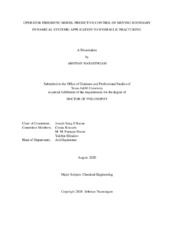| dc.description.abstract | Many chemical processes are characterized by nonlinear models with moving boundaries that describe their dynamics. Such a nonlinear trajectory can explore many regions of the state space and the spatial domains of interest as well as the dominant spatial patterns of the system change with time. Therefore, traditional model approximation methods may fail to accurately capture the dynamics. This underlines the need to develop strategies for obtaining computationally efficient yet highly accurate models that aid in the prediction and control of these systems.
In such systems, care should be taken to capture the local behavior of every portion of the solution trajectory in the state space. To achieve this, the first step of this research work computes (temporally) local reduced order models by first performing time-domain partitioning using a novel clustering strategy based on Mixed Integer Nonlinear Programming. The reduced bases are then derived within each cluster using two model reduction methods, Proper Orthogonal Decomposition (POD) and Dynamic Mode Decomposition (DMD). The proposed framework is tested on a nonlinear hydraulic fracturing process, and a Model Predictive Controller (MPC) is formulated using the (temporally) local reduced order models to design an optimum pumping schedule that ensures uniform proppant concentration for maximum oil and gas extraction.
The idea of model reduction is then extended to the parameter space in order to estimate unknown rock properties that directly affect the hydraulic fracturing process. Owing to the complex dynamics exhibited, this results in the formulation of a large- scale inverse problem that is ill-posed. To deal with this unidentifiability issue, the number of unknown model parameters are reduced while preserving the spatial features in the geological properties via POD. The statistical information is then updated using the available process measurements via a Monte Carlo data assimilation technique, the Ensemble Kalman Filter.
Although the local model reduction framework is superior in performance, a single model that is accurate within a larger domain in the state space would be beneficial in some cases. Therefore, the next part explores an alternative approach that uses Koopman operator theory to develop linear predictors to approximate nonlinear systems. Before employing it to process systems, we address several key challenges associated with it. In particular, we solve a sparse regression problem over a large set of candidate functional forms to effectively identify the required nonlinear transformation (observable functions). The developed models are shown to reveal important physical phenomena such as proppant transport and fracture propagation inside a fracture. It also highlights how a priori knowledge can be incorporated easily into the algorithm and results in accurate models that are used for controller synthesis.
Finally, Koopman theory is integrated with Lyapunov-based MPC (LMPC) for stabilizing nonlinear systems. LMPC possesses all the advantages of a standard MPC with added explicit Lyapunov constraints and is particularly suited as it explicitly characterizes a set of initial conditions starting from where the closed–loop stability can be guaranteed. By leveraging the linear structure of the Koopman models, control Lyapunov functions (CLFs) within LMPC are embedded in the nonlinear transformation to yield a standard convex (quadratic) optimization problem. This method is then improved by formulating the controller in Koopman eigenfunction coordinates, which leads to a bilinear model for control affine systems. Provided there exists a continuously differentiable inverse mapping between the original state space and (lifted) function space, the designed controller is capable of translating the feedback stabilizability of the Koopman bilinear system to the original nonlinear system. Due to the bilinear structure of the Koopman model, seeking a CLF is no longer a bottleneck for LMPC. Benchmark numerical examples demonstrate the utility of the proposed feedback control design. | en |


